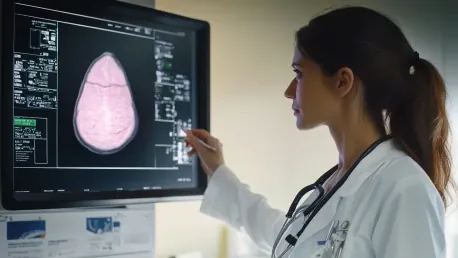The integration of Artificial Intelligence (AI) in mammography screening has emerged as a promising approach to alleviate the workload pressures faced by radiologists while ensuring high standards of cancer detection accuracy. This study, originating from Denmark, delves into the potential benefits and challenges of incorporating AI into clinical practices for breast cancer screening.
Radiologists have long been burdened by the sheer volume of mammogram readings, which demands meticulous attention to detail and immense time investment. AI offers a potential solution by reducing the caseload that radiologists need to review, thus enhancing efficiency in screening operations.
AI’s Potential in Reducing Workload
Easing the Burden on Radiologists
AI has the potential to significantly reduce the number of mammogram cases requiring human review. This technological advancement operates by automating the initial analysis of mammograms, which filters out low-risk cases and allows radiologists to focus solely on more complex or high-risk instances. Reducing the number of manual readings a radiologist must perform streamlines the workflow, minimizes the risk of human error due to fatigue, and allows medical professionals to allocate more time to cases requiring intricate review.
The implementation of AI in mammography screening not only aims to reduce the workload but also enhances patient care by ensuring that every radiologist’s expertise is directed towards the cases that most require their attention. By relieving some of the radiologists’ burdens, AI permits them to work more efficiently and reduces overall burnout, potentially maintaining higher job satisfaction and lowering job turnover rates within the field of radiology.
Enhancing Efficiency in Screening Processes
Efficiency is another significant benefit of incorporating AI in mammography screening. The study conducted in Southern Denmark demonstrated that AI could manage up to 48.8% of the screenings, substantially decreasing the workload on radiologists. This enhanced efficiency enables quicker turnaround times for patient results, which is a critical aspect in breast cancer detection and subsequent treatment initiation. A timely diagnosis can dramatically improve a patient’s prognosis and the chance of successful treatment, highlighting the urgent need for efficient screening processes.
Beyond just increasing speed, integrating AI into mammography workflows can improve the overall quality of care by reducing delays that often occur due to radiologists’ high workload. Faster screenings mean that patients spend less time anxiously waiting for results, which can significantly enhance patient experience and satisfaction. The ability of AI systems to rapidly process large volumes of data and identify potential abnormalities within mammograms ensures that patients receive prompt and accurate assessments, subsequently leading to timely and potentially life-saving interventions.
Ensuring Cancer Detection Accuracy
Balancing Automation and Precision
While AI’s potential to reduce the radiologists’ workload is significant, maintaining—or even improving—diagnostic precision remains paramount in breast cancer screening. The study meticulously evaluated AI’s performance against the standard double-readings provided by human radiologists to ensure that the technology did not compromise cancer detection accuracy. This balance between automation and precision is crucial because an erroneous reading, whether it be a false negative or a false positive, could have severe implications for patient health and well-being.
The comparison of AI and human radiologists revealed that appropriately integrated AI systems could maintain high levels of diagnostic accuracy. In some cases, AI demonstrated slightly improved detection rates when compared to traditional methods. Maintaining this high accuracy ensures that patients continue to receive reliable diagnoses, preventing missed diagnoses of cancer and avoiding unnecessary further testing for false positives. This meticulous attention to balancing automation with precision renders AI a reliable aid in breast cancer screening processes.
Detailed Comparison of AI Integration Scenarios
The research explored three distinct AI integration scenarios: replacing the first radiologist, replacing the second radiologist, and using AI as a triage tool. Each scenario was assessed for its impact on workload reduction and cancer detection accuracy to provide a comprehensive insight into AI’s efficacy. Replacing the first radiologist with AI demonstrated a 48.8% reduction in workload and maintained cancer detection rates. Replacing the second radiologist achieved a 48.7% reduction alongside a slight drop in recall rates by 2.2%, though it displayed a minor reduction in sensitivity.
In the scenario where AI served as a triage tool, the technology distinguished between low-risk and high-risk cases independently, referring only moderate-risk cases for human review. This approach delivered the highest workload reduction (49.7%) while marginally improving cancer detection rates compared to standard practices. These findings present AI not merely as a tool to replace a radiologist but as a strategic partner that can optimize workload distribution and maintain quality in diagnosis. The data substantiate AI’s role in enhancing the screening process without compromising the integrity of cancer detection accuracy.
Effective Integration Planning
Strategic Implementation
Integrating AI tools into clinical workflows requires meticulous and strategic planning. To maximize AI’s potential benefits and sustain diagnostic accuracy, changes to workflow processes must be carefully considered. This includes the need for adjusting existing workflows, training radiologists to effectively leverage AI tools, and constantly monitoring the AI’s performance in real-world applications. Effective integration also demands a collaborative approach where radiologists and AI engineers work together to refine the technology’s predictive algorithms continuously.
Understanding the limitations and strengths of AI systems can help institutions create strategic implementation plans ensuring that the technology complements the expertise of human radiologists. This synergy promotes enhanced diagnostic outcomes while maintaining an efficient workflow. Proper training and adaptation to new workflow adjustments will empower radiologists, allowing them to make informed decisions using AI insights and ultimately leading to improved patient care and operational efficiency.
Addressing Legal and Ethical Considerations
Incorporating AI into medical practices does not come without its challenges. Legal, ethical, and practical considerations are paramount and must be addressed effectively to ensure compliance and acceptance of AI technologies. Current national guidelines often restrict the complete replacement of human radiologists due to regulatory and safety concerns, making hybrid approaches more feasible and essential at this juncture. Ethical considerations, such as patient consent and the transparency of AI decision-making processes, must be thoughtfully navigated to foster trust in AI-integrated screening.
Equally important is the consideration of potential automation bias, where over-reliance on AI might occur, adding another layer of challenge. Radiologists must remain vigilant and use AI tools as aids rather than replacements, consistently verifying AI-generated data to avoid misdiagnosis. Legal frameworks must evolve to accommodate advancements in AI technology, providing clear guidelines delineating the responsibilities and extent of AI use in medical diagnostics. Continuous dialogue between healthcare providers, AI developers, regulatory bodies, and ethicists will pave the way for the responsible and effective integration of AI in clinical settings.
Real-World Application Challenges
Automation Bias and Software Limitations
As promising as AI integration in mammography screening may be, it is not without its real-world implementation challenges. One of the primary concerns is automation bias, where there’s a risk that radiologists might overly rely on AI-generated results, potentially overlooking nuances that a human eye might catch. Ensuring that radiologists maintain their vigilance and critical thinking skills when using AI tools is essential to mitigate this risk. Regular training programs focusing on balancing AI outputs with professional judgment can help address automation bias effectively.
Furthermore, limitations related to AI software’s compatibility across various vendors and different demographic populations present significant hurdles. AI systems may exhibit varying performance levels based on the data they were trained on, which could affect the generalizability and reliability of the technology. The study’s results, while promising, warrant careful consideration of these limitations and necessitate ongoing adjustments and evaluations to ensure that AI functions effectively across diverse populations and in different clinical settings.
Population Demographics and Regional Variability
The Danish cohort used for the study, with its specific population characteristics, might not represent diverse populations globally. This raises a pertinent issue: the necessity for region-specific validations to ensure AI tools’ efficacy and reliability across different demographic groups. Without such validation, there’s a risk that AI’s performance could falter when applied to populations that differ significantly from the one it was trained on.
For instance, differences in breast density, genetic predispositions, and varying incidence rates of breast cancer across regions could affect AI’s operational success. This necessitates targeted research and validation studies formatted to comprehensively understand demographic-specific behaviors and outcomes. By doing so, institutions can tailor AI tools to meet the unique needs of their patient populations, ensuring precision and effectiveness in breast cancer screening regardless of geographic or demographic differences.
Future Research and Validation
Prospective Validation Studies
Future research is crucial for validating the practical application of AI in clinical settings. It is imperative that real-life trials assess AI’s influence on clinical workflows and radiologist decision-making. Such studies help translate simulated scenarios into real-world solutions by providing empirical evidence about AI’s efficacy in practical, day-to-day operations. Prospective validation studies can offer insights into how AI integrates within various healthcare environments, revealing its impacts on workflow dynamics, diagnostic accuracy, and patient outcomes.
Dr. Elhakim and his research team have laid the groundwork for further exploration by prioritizing prospective validation studies. These studies will help refine AI algorithms based on real-world feedback and ensure that the technology remains adaptive and precise. By continuously evaluating AI’s performance in diverse clinical scenarios, researchers and healthcare providers can develop best practices for integrating AI into mammography workflows, ultimately enhancing its practical applicability and reliability.
Long-term Impact on Clinical Outcomes
The integration of Artificial Intelligence (AI) into mammography screening is emerging as a promising method to ease the workload pressures radiologists face while maintaining high standards of cancer detection accuracy. A study from Denmark explores the potential benefits and challenges of implementing AI in clinical practices for breast cancer screening.
Radiologists often struggle with the massive volume of mammogram readings, requiring meticulous attention and significant time investment. The introduction of AI offers a potential solution by decreasing the number of cases that radiologists need to review, thereby enhancing the efficiency of screening procedures. By automating part of the process, AI can help prioritize cases that need immediate attention, allowing radiologists to focus on more complex readings. However, the integration of AI must be carefully managed to address potential challenges, such as maintaining accuracy and ensuring seamless collaboration between AI systems and human professionals.









